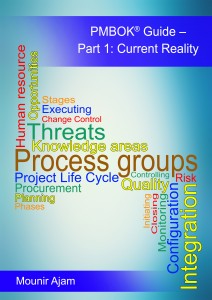What is the PMBOK® Guide Current Reality? This topic is the subject of our first e-book on the Guide, part of 2-book series. What is Missing from the PMBOK® Guide is a chapter in this first e-book. We also wrote about this in the past.
Introduction
 What is missing from the PMBOK® Guide?
What is missing from the PMBOK® Guide?
At the start of this short chapter, it is important to stress that what we include here does not mean that they are shortcomings or errors. These missing items, at least most of them, are missing by design. Meaning, the intentions from the beginning is not to have them in the guide, and we agree, they do not belong in the guide.
To clarify, these items have no place in the guide but they must be part of a project management organizational system. Therefore, what we are advocating is that the PMBOK® Guide should mention them to clarify the boundaries.
A methodology
As explained earlier, since the PMBOK® Guide design is to be a generic guide – not industry or application area specific – it does not offer a methodology. The guide advises the readers that they can use other standards or internally developed methodologies to supplement it.
Organizational system
The guide assumes that a project management organizational system already exists. The OPM system includes tools and templates, organizational assets, processes and procedures, governance and control policies, and many other elements that are necessary for effective management of projects.
Tailoring and customization
The PMBOK® Guide does not include industry/application area specific processes or knowledge areas. The lack of tailoring the guide to an application area is one of the reasons there are a few supplements to the PMBOK® Guide that are industry specific, such as for government projects, software projects, or construction projects.
Project classification
How to rank projects or classify them in term of size, complexity, or other factors is outside the guide. Also outside the guide is how to manage projects from different classification.
Project classification is important since one should treat small projects differently than large projects; simple projects are also different from complex projects. Even within the same organization, project management can vary depending on the project class. The PMBOK® Guide does not address the topic directly. It does address it implicitly and indirectly by saying that the project manager can select from the processes but we believe this is not the appropriate way to handle this important topic.
Templates and forms
The guide is not a manual and cannot be and should not be.
Projects are not one-size-fits-all, and the way to manage them is not set in stone. Therefore, the guide cannot offer fixed or set templates that would be applicable to all types of projects. As for a method, these have to be custom-fit to the organizational context.
Project life cycle
Since the guide is not industry or domain specific and is not a method, it cannot offer a fixed project life cycle.
It is important to note here that in the earlier editions, the PMBOK® Guide used to show sample project life cycles from different industries. That was helpful and should be reinstated.
Benefits realization
The definition of a project in the guide focuses on the output – the output being a product, service, or result. Whereas the project success definition should consider the outcome. Therefore, we must distinguish between output and outcome.
The output is the project end product but outcome focuses on result and benefits realization. Consequently, at least from the project owner perspective, limiting project success definition to scope, time, cost, and quality is not enough. Project success must include the success of the objectives and realizing the expected benefits. This dimension of success cannot be measured at completion or acceptance of the product. Completion and acceptance do not necessarily means success!
The topic of benefits realization is usually left to program, rather than project management.
References and External Resources
This might be a political point, related to copyrights and PMI claims for ownership of the content of the PMBOK® Guide. There are three points to stress here:
| Some asks me, “Mounir, did you submit these suggestions and this work to PMI?” My answer is no. It is likely that PMI will not accept this work for inclusion into the PMBOK® Guide without SUKAD and I assigning the copyrights to PMI, which is not something we are willing to do. |
- A good part of the content of the guide is from other sources, but nothing is referenced or credited as the source. This practice is
- Another challenge and one of the issues that led some volunteers to stop contributing to the PMBOK® Guide is PMI position on copyrights. PMI mandates that the volunteers assign their copyright to PMI for any content that they submit. In other words, the volunteers are not credited for their contributions[1].
- In the guide, it clearly states that it is a “subset of the body of knowledge.” Consequently, why is not there a reference to the other sources and external resources that can help completing the picture; as much as possible[2]?
There are other items that could be missing; however these are the main points to discuss at this time.
Suggestion for improvement
Should the guide address these points?
We are dedicating the second e-book in the series to address improvements.
[1] They are only listed in one of the appendices along with everyone else. Therefore, there is no way to tell the difference between those who contributed one sentence and others who offered major suggestions.
[2] Comment added per an input from a reviewer, Mr. Trevor K. Nelson

Trackbacks/Pingbacks